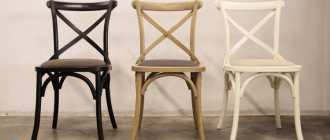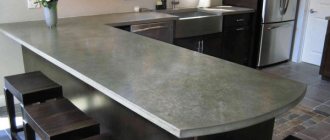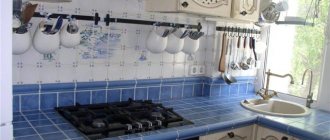Epoxy resin - what is it?
Epoxy resin, or “epoxy,” is known to almost every person who has at least once encountered the need to glue something together, and the assembled structure must be strong and reliable. However, not every person knows what epoxy resin is made of and how it can also be used for other purposes. Epoxy is a type of resin made from synthetic materials based on oligomeric compounds.
It is not used in its pure form, so before use it must be polymerized, for which a special hardener is used. By maintaining different proportions in the epoxy-hardener mixture, you can create a product that differs in its physical properties and types of application. Distinctive features of this material are: strength and resistance to chemically active substances, absence of unpleasant odor and slight shrinkage after drying.
Universal adhesive EDP is the most famous epoxy among users
Universal glue EDP
Working with epoxy resin
Take a silicone mold, wash it thoroughly and dry it. You can buy this form at craft supply stores. Next, we proceed to mixing the composition. Before doing this, be sure to read the instructions. The components of the composition should be mixed very well until smooth. Then leave the mixture for a couple of minutes to release any excess air bubbles.
Next, you should prepare the decorative elements that will be placed inside the resin. These can be dried leaves, flowers, beautiful pebbles and shells. After excess bubbles come out of the epoxy resin, you need to very carefully and slowly pour the composition into the mold to avoid overflow. Now place the decor inside the resin so that it is completely inside the composition. No elements should stick out. Otherwise, the product will turn out sloppy.
The finished form is placed in an oven heated to 80 degrees for fifteen minutes. Immediately after the mold is placed inside, the oven must be turned off. This will allow the resin to harden and dry, releasing any remaining air bubbles. After 15 minutes, you can remove the mold and leave the product to dry for another day. Only after this can the decoration be removed from the mold. To remove possible unevenness, use fine sandpaper or a file. Now the product can be varnished. The decoration is ready. Epoxy resin for creativity can be used to create various souvenirs. The sequence of actions will be the same. But epoxy is suitable for creating larger objects.
Areas of application of epoxy resin for creativity
Epoxy resin is a universal material that allows you to make beautiful products in various areas of use: jewelry and costume jewelry, interior decorative elements and furniture. For different purposes, different types of epoxy resin are used - transparent or colored, differing in the type of filler added to the composition before use.
Transparent
Transparent epoxy resin is used in the production of advertising and souvenirs, decorative and jewelry items, as well as in the creation of polymer floors with a 3D effect.
In addition, transparent epoxy is used at different stages of construction and installation work during the construction of objects of various types. The industry produces epoxy resin in liquid and solid states, which determine the sequence of work performed using it.
"Magic Crystal-3D" is ideal for creating jewelry and costume jewelry
The most popular brands of transparent epoxy resin among users are:
- “Magic Crystal-3D” - used for the manufacture of jewelry and costume jewelry, as well as for pouring glossy and 3D coatings; Magic Crystal-3D
- “Epoxy CR 100” - used in the manufacture of polymer floors;
Epoxy CR 100 - “ED-20” is one of the types of epoxy-diane resins used in the creation of casting and impregnating compositions for construction work, as well as in the production of sealants and adhesives.
ED-20
Colored
This type of epoxy resin differs from transparent only in that special fillers are used in its preparation, giving the final product a certain color.
Colored Epoxy for Jewelry Making
Fillers (surfactants) can be sold separately from the epoxy, allowing the dye to be selected to suit the desired color or be pre-packaged for future use.
Description and features
From a chemical point of view, epoxy is an oligomer containing epoxy groups, which, when combined with hardeners, turns into a cross-linked polymer that completely changes its physical properties.
Two-component resin is the type of epoxy most commonly found on sale. The first component (component “A”) is the main composition, the oligomer. The second component (component “B”) is the hardener.
Before direct use, it is necessary to first prepare the composition. The technology for preparing the compound depends on the composition of the components. The main resin can be represented by a viscous and viscous mass. You will have to add not only a hardener, but also a solvent, and possibly a plasticizer and other additives. Each manufacturer provides detailed instructions for working with the material.
The hardener is based on carboxylic acids or amines. The main chemicals are epichlorohydrin and bisphenol. Such epoxy resins are called epoxy-diane. They are most suitable as compounds for casting products and surfaces. Transparent resin, as can be seen from the name itself, differs from its “classmates” in optical indicators. Rays of light are practically not absorbed by the substance, passing through it without distortion and without darkening. This resin resembles ordinary glass in appearance. Individually, the components also have no color and are completely transparent. This makes it possible to use epoxy as a protective material for artistic creations.
It cannot be said that absolutely all brands of resins positioned as transparent remain so for any length of time. Only the highest quality materials can boast of stable performance. Other models become cloudy over time and acquire a characteristic yellowish tint.
Digressing from the topic, we note that epoxy resins intended for gluing products have a low transparency rate, and some modifications are brown and even black in color.
Resins for creativity, in addition to transparency, have another distinctive feature. As a result of the polymerization reaction, they harden quite quickly. It is recommended to use the products one day after pouring, but curing occurs after a few hours. That is why experienced craftsmen recommend a careful approach to the preparatory stage of work, so as not to be distracted during the pouring process and have time to correctly position all the decorative elements included in the product. The result gives original collages with the effect of “frozen” decorative elements. They seem to float in the air. Note that with low quality resin, such effects cannot be achieved.
Useful to know > Universal epoxy adhesive EDP and its application
Transparent epoxy resin is suitable for bulk filling like no other. To create a 3D picture, you need to place the constituent elements in different layers. Typically, products made of wood, stone, metal, as well as shells, plant flowers and other small objects are used for these purposes. The interface between the layers is not noticeable after curing, and even with layer-by-layer pouring, the mass looks monolithic.
Transparent epoxy resin is always a modified composition. Special additives increase its optical performance, and also increase the strength, elasticity and resistance of the compound to various aggressive agents. It is unlikely that you will be able to prepare such a composition yourself, since only carefully selected components guarantee non-shrinking pouring.
Along with transparency, epoxy resin has a number of unique properties inherent to this type of polymer, such as high strength, wear resistance, heat resistance, resistance to ultraviolet radiation, and environmental friendliness. The listed qualities allow the use of transparent resins for production purposes, but there are more affordable options for this. The compound for pouring and jewelry work is not so cheap, and it is the price component that sharply limits the scope of application of such resins.
Basic properties
The distinctive properties of epoxy resin, which make it a unique material, are the following indicators:
- high strength and resistance to external mechanical and chemical influences;
- waterproof;
- dielectric properties;
- ability for long-term storage in its natural state without adding a hardener;
- the ability to create different materials using the same components (resin + hardener), but in different proportions.
All positive properties become inherent in the resin only after adding a hardener. The polymerization process occurs at ambient temperatures from -15 to +80ºС.
A table made using epoxy resin will decorate any interior
Chemical composition and components for epoxy resin
As already written above, epoxy resin is a synthetic material made on the basis of oligomeric compounds. For its proper use, especially when carrying out creative ideas, it is necessary to have information about hardeners and plasticizers, fillers and solvents, using which you can expand the possibilities of using this material, as well as ensure the safety of work using it.
Hardeners
The hardener serves to polymerize the composition, under its influence the resin acquires a stable structure. Carboxylic acids and their anhydrides, as well as diamines can act as hardeners. Hardeners are classified as:
- acidic - when used, polymerization occurs at a significant temperature of +100−200°C;
- amine - hardening occurs at room temperature.
FCR-22 with FCH-T hardener has low shrinkage when used
epoxy resin FCR-22
Amine is the most popular type of hardeners, characterized by ease of use and the absence of the need for special equipment for preparing the composition. The most popular brands of hardeners are: PEPA and DETA , CHS-Hardener P-11 and RC-19 , as well as Epilox H 10-40 .
Plasticizers
The addition of a plasticizer gives the created composition plasticity and the ability to withstand external mechanical loads in the form of impact or fracture. The most common plasticizers are:
- DBP (dibutyl phthalate) - added to epoxy resin in small quantities, it protects the composition from cracking. The disadvantages of this plasticizer are: it does not mix well with the resin, and when used, prolonged mixing and heating are required;
- DEG-1 - easily mixed with resin, but has an orange color, which limits its use if it is necessary to create a transparent structure.
Plasticizers for epoxy resins:
plasticizer DEG-1
plasticizer DBP (dibutyl phthalate)
Fillers
Fillers can be used for technical or decorative purposes. Technical ones provide the necessary viscosity to the created composition, which is required when performing puttying and filling voids in building structures. The most popular materials in this group are Aerosil and Microsphere .
Decorative - give the created product a certain color and texture. This can be quartz sand or crumbs of various colors. Colored fillers are especially in demand when using a creative approach to the manufacture of products, regardless of whether they are pieces of furniture or decor, poured floors or jewelry.
Decorative fillers used in the manufacture of various products
Solvents
There are times when when making something, resin gets onto a finished product or clothing, and it needs to be removed before it has time to dry. In this case, solvents come to the rescue, which can be acetone, toluene, ethyl acetate, butyl acetate or nail polish remover. In addition, solvents are used to reduce the viscosity of the resin, which is necessary when performing certain operations using it.
When using solvents, remember that:
- even a small amount of solvent can significantly reduce the viscosity of the prepared composition;
- the use of a solvent reduces the strength of the final product and its hardening time;
- the solvent causes shrinkage and may cause discoloration of the final product.
About pouring technology
The technology for creating self-leveling floors is not much different from the use of other types of self-leveling floors.
- Preparation of the grounds. Without this, clear epoxy resin will not give the desired result.
In this sense, cement-sand screed is considered one of the most reliable materials. They produce filling options for tiles and wooden surfaces. But such designs only complicate the work.
An even surface and a dry base are the main requirements in this case. When floor humidity is more than 4%, moisture begins to destroy the materials with which it interacts. Concrete with an old screed is pre-cleaned from dirt and dust. In other cases, you need to wait at least 4 weeks. Most attention is paid to leveling the surface.
- Padding.
It is assumed that the materials will be applied in two layers. When the first of them is completely dry, it is important to make sure that there are no glossy areas left on the surface. Otherwise, they are cleaned and coated with primer again. Only in this case will transparent epoxy resin for the floor give the desired result.
After the first layer comes the second. It is sprinkled with quartz varieties of compositions. Not earlier than in a day, such a surface will dry on its own.
- Base layer.
Apply it in stripes. The main thing is to evenly distribute the material using a squeegee and spatula. The surface is rolled with a needle roller to avoid the appearance of air bubbles.
- Finish coating.
At least 2 days must pass before this layer. And after the base one is used. Before the finishing layer, you can create another one, with a decorative purpose. The main thing is that the appearance harmoniously complements the surrounding space. Such solutions, if necessary, help to divide the room into several zones.
How to use epoxy resin
When working with epoxy resin, it is necessary to maintain certain proportions, because the ratio of hardener and resin affects the physical properties of the resulting product and the time it hardens.
Working with epoxy resin requires careful preparation
How to dilute epoxy resin with hardener
The proportions of hardener and resin, as a rule, are always indicated by the manufacturers of these substances on their packaging or in the accompanying documentation, which simplifies the process of preparing the final product. The general preparation procedure can be described as follows:
- before cooking, it is recommended to heat the resin, but not to bring it to a state of boiling or crystallization;
- if crystallization has occurred, the resin can be returned to its original state by heating it to a temperature of +40°C with constant stirring;
- Resin is poured into the prepared container or mold, after which a hardener is added;
- both components are thoroughly mixed using a wooden stick or other durable object;
Important! When mixing epoxy resin and hardener, it is not recommended to use a power tool because... a large number of mixer revolutions can have a negative impact on the structure of the created product.
- after mixing, the reaction cannot be stopped, so it is initially necessary to decide on the proportions of the materials to be mixed or even do a test mixing.
Wood and epoxy resin are successfully combined in the manufacture of furniture and interior items
Preparation and use in large quantities
When pouring a floor or making large structural elements of furniture and interior items, large amounts of epoxy resin are required. In this case, the complexity of the work lies in ensuring uniform heating of the required volume and maintaining the set temperature for a certain time necessary for its use. The required result can be achieved by using a water bath, with which the resin is heated to a temperature of +50..+55°C with constant stirring, after which this temperature is maintained.
Important! If the temperature of the prepared composition exceeds +60˚С, then crystallization will be inevitable.
Preparation and use for small items
When preparing epoxy resin in small volumes, mixing is done using a cold method.
Epoxy resin crafts using natural plants
For conventional bonding, the ratio of resin to hardener is 1:10, i.e. There are ten parts of resin per one measured part of hardener. Work is performed at room temperature. Mixing must be done with special care; the resulting composition should not contain air bubbles, it should have a uniform and viscous consistency.
What else you need to know about transparency
Components that are transparent at first glance do not guarantee that their optical properties will be retained after curing. Almost all epoxy resins in the form of separated components are colorless and transparent. Only a small proportion of semi-finished products have a subtle yellow tint. It is impossible to hope that nothing will happen to transparency after the reaction. But you should still pay attention to your own shade when choosing a compound. While transparent components may become cloudy after mixing, resin-colored resins will not become crystal-like.
It is important to understand that the same brand of resin may vary in color. For example, the widely popular epoxy ED-20 is manufactured strictly in accordance with GOST. However, the standard allows the chromaticity value to fluctuate from 0 to 4. Without going into details, we note that the compound may look like glass or acquire a yellow tint. When purchasing, you should pay attention to the number of fillers. In its simplest, unmodified form, it is yellow. Practice shows that you can end up with a “not entirely successful batch”, so many craftsmen began to give preference to more expensive, but also higher quality materials.
Good to know > French epoxy resin Pebeo Gedeo
Jewelry resins have high viscosity while maintaining transparency. You should not focus on viscosity alone. There are thick resins that are not intended for creativity. If you try to fill, air bubbles will form inside the layer. A large number of them creates a visual effect of clouding the material. You can get rid of bubbles by heating the resin with a hairdryer, but due to the large number of them, the work becomes very labor-intensive.
Yellowing of the resin occurs under the influence of factors such as ultraviolet radiation and oxidative reactions. Many resins successfully resist radiation. It is believed that it is not significant for epoxy. In fact, sunlight does have some effect on the compound. But even if you manage to choose a high-quality brand that is resistant to light, you will not be able to get rid of the effects of oxygen, that is, in the long term you need to be prepared for a change in transparency.
Today there is no need to understand the technical parameters of a material in order to engage in creativity. Many manufacturers position their models as resins for narrow applications. You can easily find resin for pouring floors or for making furniture, and those grades that are suitable for the production of costume jewelry are called “jewelry resin.”
In special jewelry resins, all components are carefully selected, as a result of which the material is characterized by fluidity, the absence of its own shade and the necessary plasticity indicators. By the way, the addition of antioxidants and UV protectors can increase transparency. In addition to these parameters, clear resins can withstand single-layer pouring. The maximum permissible layer is an important indicator that must be taken into account. Compounds allow you to pour layers up to 5 cm thick.
Characteristics of a popular variety - brand ED-20
Brand ED-20 is a two-component epoxy resin created on the basis of an oligomeric compound, for which a variety of bioorganic substances serve as hardeners. Depending on the hardener used and the proportion used, the physical properties of the resulting composition, as well as technical and operational characteristics, can vary significantly.
ED-20 is sold in different packaging, which is convenient for different needs
Epoxy grade ED-20 can be used for:
- creating composite materials in their pure form;
- production of epoxy adhesives and sealants;
- creation of reinforced plastic and protective coatings.
ED-20 is an explosion-proof material, but when exposed to open fire it supports combustion. In terms of the degree of danger to human health, ED-20 belongs to hazard class 2, because contains toluene and epichlorohydrin in small quantities.
Safety rules when working with ED-20
In order to work competently with epoxy resin, you need to know what safety rules must be followed during their implementation:
- To dilute epoxy resin, you cannot use utensils used for cooking and eating food;
- when applying and applying the composition, it is necessary to use personal protective equipment (overall clothing, gloves);
When working with epoxy resin, you must follow safety regulations
- when processing a poured surface (grinding, grouting), it is necessary to use safety glasses and a respirator;
- the resin must be stored in a tightly closed container, and its shelf life must correspond to that recommended by the manufacturer;
- if resin gets on the skin, it should be removed, after which the area of contact should be washed with warm water and soap and treated with a disinfectant;
- if work is carried out indoors, it must be equipped with supply and exhaust ventilation.
Useful tips
- Epoxy resin is a chemical with a distinct synthetic odor. If safety precautions are not followed, it irritates the mucous membranes and can cause harm to health. Work should be done in a ventilated area. Buy materials only from trusted manufacturers so that the creative process is filled with only pleasant moments.
- Depending on the manufacturer, the ratio of resin components differs. Therefore, be sure to read the instructions.
- Epoxy resin can be used to create countertops, shelves, and other design elements. But before moving on to larger items, hone your skills on smaller pieces.
- Epoxy resin should not be used to create items that come into contact with food. This material is not suitable for glasses and plates.
At what price to buy epoxy resin for creativity
Epoxy resin for creativity is a specific product that cannot be purchased in a supermarket or convenience store. The sale of such goods is carried out by trade organizations specializing in chemical industry products, selling paints and varnishes and goods for creativity. The price of epoxy resin in different organizations can vary greatly, so before purchasing it is necessary to study the market for these products, both when selling them live and through online resources.
Specialized companies offer a fairly wide range of different types of resins and components for them.
The following table shows the cost of various types of epoxy resin used for creativity, when sold via the Internet, as of the beginning of the 2nd quarter of 2020.
| Resin grade | Packaging, kg | Contents of delivery | Price (as of April 2020), rub. |
| "MG-EPOX-GLASS" (jewelry) | 0,3 | resin + hardener | 560 |
| jewelry resin MG-EPOX-GLASS | |||
| "ArtLine Crystal Epoxy" (for jewelry and decor) | 0,1 | resin + hardener + measuring cup + gloves | 390 |
| ArtLine Crystal Epoxy | |||
| "SMOL200-V" (jewelry) | 0,2 | resin + hardener | 695 |
| SMOL200-V | |||
| "PEO-10K" (for volumetric coatings) | 0,3 | resin + hardener | 1200 |
| "ED-20" | 1 | resin | 700 |
ED-20











